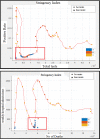COVID-19 Variants and Transfer Learning for the Emerging Stringency Indices
- PMID: 35573262
- PMCID: PMC9087157
- DOI: 10.1007/s11063-022-10834-5
COVID-19 Variants and Transfer Learning for the Emerging Stringency Indices
Abstract
The pandemics in the history of world health organization have always left memorable hallmarks, on the health care systems and on the economy of highly effected areas. The ongoing pandemic is one of the most harmful pandemics and is threatening due to its transformation to more contiguous variants. Here in this manuscript, we will first outline the variants and then their impact on the associated health issues. The deep learning algorithms are useful in developing models, from a higher dimensional problem/ dataset, but these algorithms fail to provide insight during the training process and do not generalize the conditions. Transfer learning, a new subfield of machine learning has acquired fame due to its ability to exploit the information/learning gained from a previous process to improve generalization for the next. In short, transfer learning is the optimization of the stored knowledge. With the aid of transfer learning, we will show that the stringency index and cardiovascular death rates were the most important and appropriate predictors to develop the model for the forecasting of the COVID-19 death rates.
Keywords: Artificial intelligence; COVID-19 socioeconomic problems; Stringency index; Transfer learning.
© The Author(s), under exclusive licence to Springer Science+Business Media, LLC, part of Springer Nature 2022.
Conflict of interest statement
Conflict of interestThe authors declare that there is no conflict of interest.
Figures
References
-
- Al-Utaibi KA, Sohail A, Yu Z, Arif R, Nutini A, Abdel-Salam A-SG, Sait SM. Dynamical analysis of the delayed immune response to cancer. Results Phys. 2021;26:104282. doi: 10.1016/j.rinp.2021.104282. - DOI
-
- Banos O, Calatroni A, Damas M, Pomares H, Roggen D, Rojas I, Villalonga C. Opportunistic activity recognition in iot sensor ecosystems via multimodal transfer learning. Neural Process Lett. 2021;53:1–29. doi: 10.1007/s11063-021-10468-z. - DOI
-
- Fan J, Lee J, Lee Y. A transfer learning architecture based on a support vector machine for histopathology image classification. Appl Sci. 2021;11(14):6380. doi: 10.3390/app11146380. - DOI
-
- Lee Y, Chung M, Cho S, Choi J. Extraction of product evaluation factors with a convolutional neural network and transfer learning. Neural Process Lett. 2019;50(1):149–164. doi: 10.1007/s11063-018-9964-8. - DOI
LinkOut - more resources
Full Text Sources


